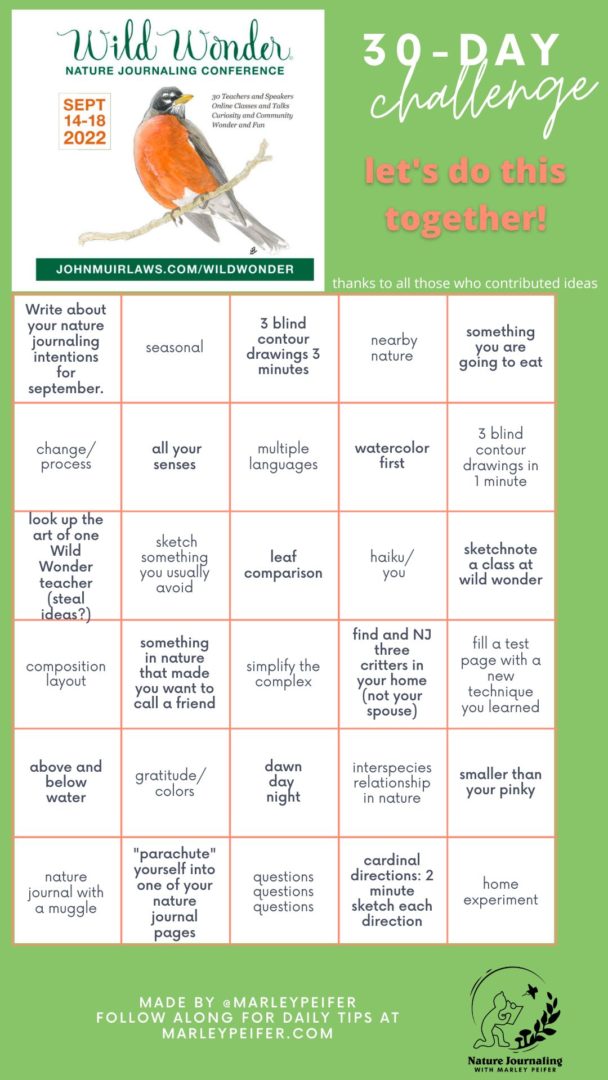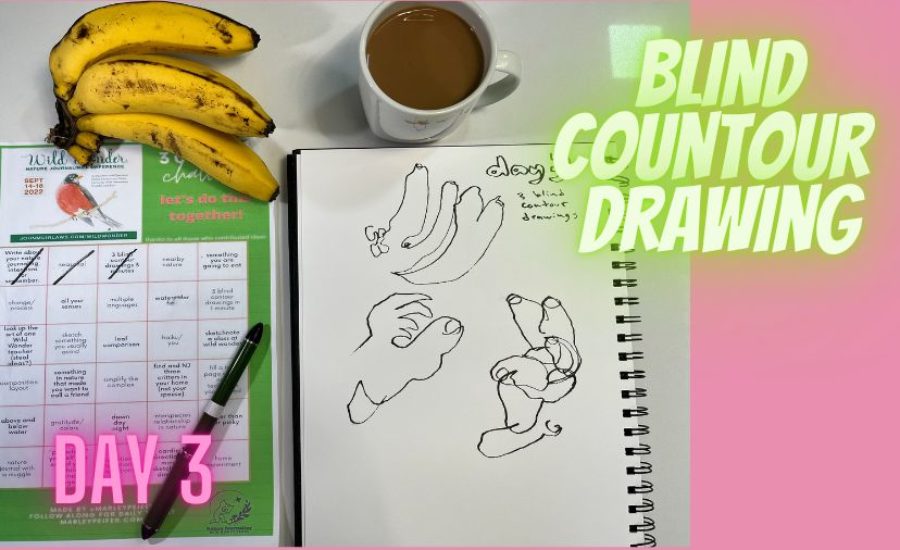Have you ever done blind contour drawings before?
Today’s Prompt: “Three blind contour drawings in three minutes”
Blind contour drawing might be the single best exercise for improving your drawings. In addition, it is a great warmup. Sometimes, I wish I did it before every nature journaling session. This technique is so good that I have included it twice in the thirty day nature journaling challenge. Whether you are attending the Wild Wonder nature journaling conference this month or not doing blind contour drawing several times will help you.
How do you do blind contour drawing?
- First, use a sheet of paper that is about A4 size. If it is much smaller it will be harder. You can do it in your nature journal or if you are really precious about your journal you can use scrap paper. It is good if the paper can not slide around too much.
- Next, choose a subject. The classic subject is your non-dominant hand. However, you can also use a leaf, a fruit, a seed pod, a person, or a houseplant.
- Now the fun part! Hold your subject at arms length and away from your drawing hand. This is essential. The subject must be far enough from your drawing that you can not see the drawing! You will be drawing blind.
- Look at your subject intently and start drawing. Try to draw without lifting your pen or pencil from the paper (otherwise you lose your spot). Do your best to observe your subject and translate what you see into the movements of your hand.
- After about a minute you can stop. There is usually no point to going much longer because you don’t know where you are on the drawing. Part of the idea is to move fast.
- Finally, look at your drawing. You might laugh. Or you might be shocked. Perhaps the drawing is better in some ways than your usual drawings!
- Last but not least, do some more. This exercise works best if you do a lot and do them frequently.
What are the benefits of blind contour drawing?
- Detachment from outcome. Since you are using a weird technique you don’t have to take the outcome personally. “Haha, look at that silly drawing.” Instead of “OMG, that drawing looks terrible.” Detachment from the outcome is one of the most important skills in all of art and is essential for learning.
- Speed. This practice forces you to work faster which is a good skill especially for some people (you know who you are.) Very helpful for field sketching and nature journaling.
- Economy of lines. Because you can’t lift your pencil from the paper you sometimes have to backtrack across the paper and make those lines count. This ability will prove itself useful in the future and can be seen in the drawings of great masters such as Picasso. In addition to fine art this has many applications to Nature Journaling.
- Page “navigation” sense. Because you are not looking at the paper you have to develop your awareness of “navigation” on the page. Where is your pencil at any given moment? This ability will help you when you are nature journaling a rare animal. How many precious seconds will you have to observe this creature? How often do you need to look down at the page to see where your hand is? Or do you have the skills to jot down some info without looking away from that mountain lion?
- Ratio of looking. As a nature journaling teacher and field sketching teacher I get to learn from watching my students. One thing I watch is the ratio of time that people spend looking at the subject versus looking at their drawing. Is it 50/50? Probably not even close. People tend to drift off into a narcissistic love trance with their own drawing, spending more and more time looking at it and polishing it instead of looking at the subject. They are probably at a ratio of 10/90 with 90% of their time spent looking at their drawing. We all do this. Blind contour drawing forces us to make the ratio 100/0. This is important for all drawing from life but it is absolutely essential to nature journalers. If we spend 90% of our time in nature looking at our page and only 10% looking at nature then what are we actually doing?
- Looseness. Some people are free and loose with their drawings, some people find this hard (myself included). Blind contour drawing is the perfect way to loosen up.
- Creative unlock. Sometimes, we just don’t know where to start. We are bored, we don’t know what to draw. Even worse, we could be stuck in the more intellectual part of our brain. Doing a blind contour drawings of your hand for a few minutes can get your creative juices flowing. You can’t overthink it.
Here is the Full 30 day Challenge!
Use these hashtags if you post your progress online: #naturejournalingchallenge #wildwonder2022

